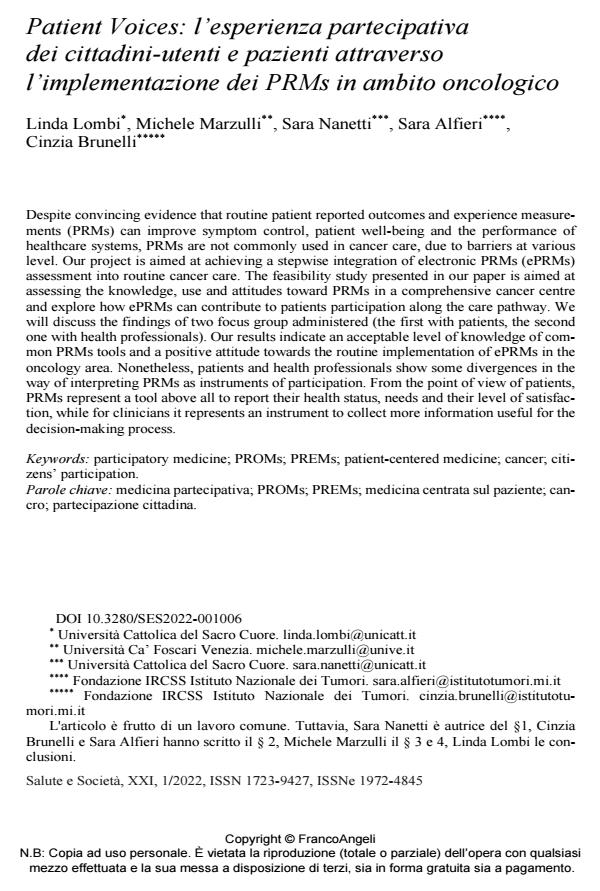Patient Voices: l’esperienza partecipativa dei cittadini-utenti e pazienti attraverso l’implementazione dei PRMs in ambito oncologico
Journal title SALUTE E SOCIETÀ
Author/s Linda Lombi, Michele Marzulli, Sara Nanetti, Sara Alfieri, Cinzia Brunelli
Publishing Year 2022 Issue 2022/1
Language Italian Pages 17 P. 80-96 File size 213 KB
DOI 10.3280/SES2022-001006
DOI is like a bar code for intellectual property: to have more infomation
click here
Below, you can see the article first page
If you want to buy this article in PDF format, you can do it, following the instructions to buy download credits

FrancoAngeli is member of Publishers International Linking Association, Inc (PILA), a not-for-profit association which run the CrossRef service enabling links to and from online scholarly content.
Despite convincing evidence that routine patient reported outcomes and experience measure-ments (PRMs) can improve symptom control, patient well-being and the performance of healthcare systems, PRMs are not commonly used in cancer care, due to barriers at various level. Our project is aimed at achieving a stepwise integration of electronic PRMs (ePRMs) assessment into routine cancer care. The feasibility study presented in our paper is aimed at assessing the knowledge, use and attitudes toward PRMs in a comprehensive cancer centre and explore how ePRMs can contribute to patients participation along the care pathway. We will discuss the findings of two focus group administered (the first with patients, the second one with health professionals). Our results indicate an acceptable level of knowledge of com-mon PRMs tools and a positive attitude towards the routine implementation of ePRMs in the oncology area. Nonetheless, patients and health professionals show some divergences in the way of interpreting PRMs as instruments of participation. From the point of view of patients, PRMs represent a tool above all to report their health status, needs and their level of satisfac-tion, while for clinicians it represents an instrument to collect more information useful for the decision-making process.
Keywords: participatory medicine; PROMs; PREMs; patient-centered medicine; cancer; citi-zens’ participation.
Linda Lombi, Michele Marzulli, Sara Nanetti, Sara Alfieri, Cinzia Brunelli, Patient Voices: l’esperienza partecipativa dei cittadini-utenti e pazienti attraverso l’implementazione dei PRMs in ambito oncologico in "SALUTE E SOCIETÀ" 1/2022, pp 80-96, DOI: 10.3280/SES2022-001006